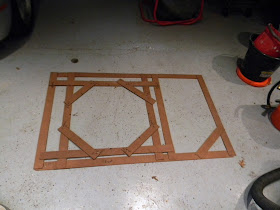With the first set of glass reinforced concrete countertop test panels I decided to test a bunch of different sealers to see how they did against some harsh kitchen tests. Wine, mustard, vinegar, and a hot bolt were used to test the effectiveness against normal conditions.
The test sections included:
1. Control
3. Cheng Sealer + Wax
4. Cheng Siloxane
5. Cheng Siloxane + Wax
6. Wax
10. Eco Tuff + Acrisoy
12. Densifier + Acrisoy
15. Penofin Verde Green Oil (Two coats)
All sealers were applied according to the manufacturer's recommendations and allowed to dry 48 hours before testing.
The first panel had the control, cheng sealer, and siloxane. The Cheng sealer is a penetrating acrylic. The Cheng sealer has a nice sheen that held up through all of the tests. Siloxane is a highly effective sealer used on exterior concrete, especially decorative. Other than the sheen from the sealer, the color was the same for these.
The second panel had the soy based products. Acrisoy is a penetrating acrylic which produces a slight sheen. The eco tuff is a penetrating soy epoxy primer for industrial floors. The eco tuff produces a darker wet look.
The third panel contains seal green, a side walk sealer and the green wood oil at one and two applications. And a hole when I stripped the forms too soon. The seal green didn't really change the color. The oil produced an oiled finish as expected.
The last panel had a lithium silicate densifier, wax, siloxane and wax, and a butcher block sealer. The butcher block sealer gave the concrete a brown, antique look.
After all sealer had been applied and allowed to dry they were tested. The tests included water, red wine, vinegar, mustard, and a hot bolt. Vinegar, red wine, and mustard are all acidic and will attack cement paste. Acid color stains use the acid to etch the concrete and allow the coloring to penetrate. So the mustard and wine will erode the paste and leave color behind. Ideally you don't want a countertop to stain every time something hits the surface. All liquids were left on for 5 hours to really soak in. Ideally you wouldn't leave red wine or mustard on your countertop overnight, but this was a worst case test. After the 5 hours I washed the surface with hot soapy water and a magic eraser.
The hot bolt is probably too severe. I used this test to get an idea of what color the sealer might turn if you put a really hot pan on the surface.
Here is the control section during testing. Clearly all of the liquids soaked into the surface. The hot bolt did leave a burn mark.
The acrylics did a good job of keeping the liquids on the surface.
The butcher block sealer also did a good job.
Here is the control panel after testing. Everything was compared against the control (upper left) performance. The water left a spot. The red wine left a dark stain. The vinegar dissolved the surface paste. The mustard dissolved the surface paste and left a yellow stain. The Cheng sealer alone had the best performance from this group (upper right). The siloxane didn't seem to do much. Wax didn't seem to help the sealer.
This is the soy based sealer panel. The acrisoy had similar performance to the Cheng sealer. The eco tuff epoxy generally had good performance too. It was discolored by the vinegar and burned by the bolt. The densifier reduced the effectiveness of the acrisoy. The acrisoy coated on top of the eco tuff didn't improve performance. Since the acrisoy is meant to penetrate, it doesn't work as well when coating over the epoxy.
Here is the wax, siloxane, densifier, butcher block sealer group. The wax, siloxane, and densifier really didn't work. Their performance was similar to the control. The butcher block sealer had good performance. The dark color helps hide staining too.
The wood oil and sidewalk sealer didn't have great performance.
I summarized the testing in the table below. Everything is compared against the control. NA means there wasn't anything to mention.
From this testing I would recommend three sealers. The two penetrating acrylic sealers did a good job (Cheng and Acrisoy) and so did the butcher block sealer. The acrylic sealers add a little sheen but don't change the concrete color. So if you want to use those, get the color you want from the dry concrete before application. The butcher block sealer is brown and will give the concrete an antique look.























































